If you do NOT see the Table of Contents frame to the left of this page, then
Click here to open 'USArmyGermany' frameset |
Quartermaster in USFET & EUCOM 1940s
US Forces in the European Theater
Looking for more information from military/civilian personnel assigned to or associated with the U.S. Army in Germany from 1945 to 1989. If you have any stories or thoughts on the subject, please contact me . .
|
|
|
|
| |
| The 1940s |
|
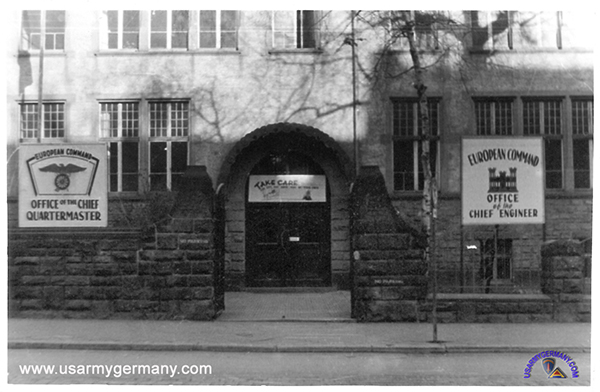
Lurgi Haus, Gervinus Strasse, Frankfurt, around 1947 (Webmaster's collection) |
|
| 1947 |
| (Source: Vol. IV, The Second Year, OCCUPATION FORCES SERIES, 1947) |
| The Office of the Chief Quartermaster was located at the Lurgi Haus in Frankfurt until the end of April 1947, when it moved to the Elizabethen School on Eschershemer Landstrasse, within the Frankfurt (Headquarters) Compound. |
|
|
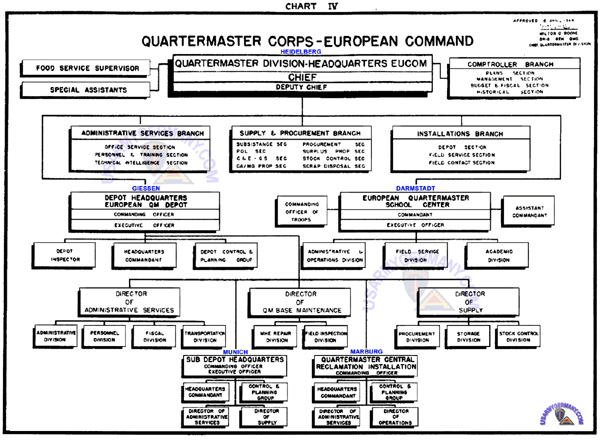
Quartermaster Division, EUCOM, April 1948 (Click on image to enlarge) |
|
| 1948 |
| (Source: Vol. IV, 4th Quarter, The Third Year of Occupation, OCCUPATION FORCES SERIES, Hq EUCOM, 1948) |
1. Office Organization.
In conformance with orders from Headquarters, EUCOM of 8 April, the Office of the Chief Quartermaster was redesignated as the Quartermaster Division, its main subdivisions were entitled branches, and. subdivisions of the branches became known as sections. The directors of both branches and section were entitled "chiefs." Chart IV shows the organization of the Qartermaster Division as it was approved on 16 April. The Office was made up of four branches, which were subdivided into 18 sections.
2. Staff Executives.
After having served as Chief Quartermaster in the European Command since June of 1946, Brig. Gen. Milton 0. Boone returned to the United States for retirement from the service, being succeeded by Col. Samuel W. Smithers, who became Acting Chief of the Quartermaster Division on 27 May. Formerly the Constabulary Quartermaster, Col. Smithers was appointed Special Assistant to the Chief of the Quartermaster Division on 21 April, in which capacity he had become acquainted with the duties he was to perform as acting chief of the division. Lt. Col. Charles P. Bellican continued to serve as Deputy Chief of the Quartermaster Division, and Lt. Col. Patrick H. Buckley as Food Service Supervisor. On 30 June branch and section chiefs in the office were as follows: |
| |
| |
 UNIT UNIT |
|
 CHIEF CHIEF |
| |
Comptroller Branch |
|
Lt Col Quentin L. Kendall |
| |
 Plans Section Plans Section |
|
Maj Leonard D. Martin |
| |
 Management Section Management Section |
|
Maj Upton A. McGill |
| |
 Budget & Fiscal Budget & Fiscal |
|
Lt Col Robert B. Southworth |
| |
Administrative Services Branch |
|
Lt Col Harold H. Shaller |
| |
 Office Service Section Office Service Section |
|
Capt Bryce J. Torrence |
| |
 Personnel & Training Section Personnel & Training Section |
|
Maj John W. Maxwell |
| |
Supply & Procurement Branch |
|
Lt Col James M. Illig |
| |
 Subsistence Section Subsistence Section |
|
Maj H.C. Mertens |
| |
 Clothing & Equipage Section Clothing & Equipage Section |
|
John G. Peters |
| |
 General Supplies Section General Supplies Section |
|
Maj Hudson R. Hurst |
| |
 POL Section POL Section |
|
Lt Col Victor H. Moore |
| |
 Civil Affairs & Military Government Section Civil Affairs & Military Government Section |
|
Capt John C. McCool |
| |
 Stock Control Section Stock Control Section |
|
Maj Ivan P. Egeler |
| |
 Surplus Property Section Surplus Property Section |
|
Maj Ernest W. Raabe |
| |
 Procurement Section Procurement Section |
|
Lt Col Ralph S. Hardiman |
| |
 Scrap Disposal Section Scrap Disposal Section |
|
Capt Harold G. Catlett |
| |
Installation Branch |
|
Lt Col Jay T. Glen |
| |
 Depot Section Depot Section |
|
Maj Folkley L. Johnson |
| |
 Field Service Section Field Service Section |
|
Lt Col Lorne Wilkie |
| |
 Field Contact Section Field Contact Section |
|
Lt Col Warren G. Davis |
|
| |
| 3. Personnel Strength.
Enlisted men and women on the staff of the Quartermaster Division numbered only 44 on 30 June, although the authorization for enlisted personnel remained at 63 spaces. The 36 Army officers assigned to the Quartermaster Division at the end of June exactly filled the authorization for such personnel. In accordance with command policy, the number of Allied nationals employed on the staff decreased from 51 on 1 April to 45 on 30 June. The following tabulation indicates the number of military and civilian personnel who were under the jurisdiction of the Chief, Quartermaster Division, at the end of each month during, the period under consideration: |
| |
|
Category |
April |
|
May |
|
June |
|
|
| |
|
|
|
|
|
|
|
|
| |
US Civilians |
218 |
|
217 |
|
213 |
|
|
| |
Allied Civilians |
47 |
|
44 |
|
45 |
|
|
| |
German Civilians |
8,866 |
|
9,165 |
|
9,943 |
|
|
| |
Military Personnel |
2,010 |
|
2,027 |
|
1,923 |
|
|
| |
 Totals Totals |
12,141 |
|
11,453 |
|
12,124 |
|
|
|
| |
| 4. Quartermaster Units.
During the quarter under review (1 April - 30 June 1948) three Quartermaster companies were activated and none were inactivated. On 5 April the Constabulary Quartermaster Company, Infantry Division (Provisional), less 3 car platoons, was organized at Darmstadt with 7 officers and 92 enlisted men. On the same date the Constabulary Quartermaster Railhead Company (Provisional), less 1 platoon, was activated at Giessen with a strength of 3 officers and 99 men. On 11 April both units were attached to the 2d Constabulary Regiment for administration and supply. The 502 Labor Supervision Company, Headquarters was activated at Giessen on 20 June with 2 officers and 7 men.
Units of the Quartermaster Corps which were stationed in the European Command and in the US Zone of Austria at the end of June are shown in Table XVIII. |
| |
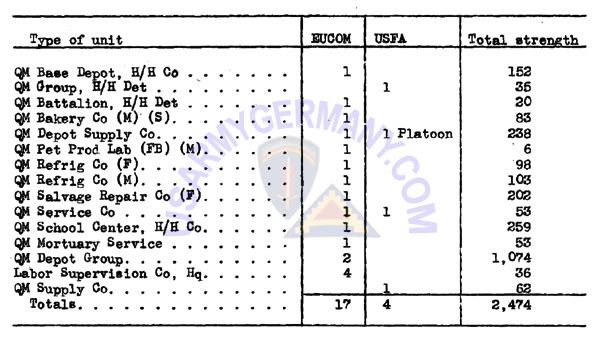
Table XVIII: Quartermaster Units in European Command (click here for troop list) |
| |
| 5. The Installations Branch.
 a. Activities. Quartermaster installations were supervised by the Chief, Installations Branch. This branch interpreted policies affecting depot installations and operations in the field. The Field Contact Section, under the Installations Branch, conducted technical inspections, surveys, and studies and reported on them to the branch. The Field Service Section directed zone-wide quartermaster services, including mortuary facilities, laundries for troops and Army institutions, remount and canine activities, and reclamation and repair installations. When considered necessary, this section also recommended changes in policies and practices affecting quartermaster installations, aided supply sections of major commands and military districts in maintaining efficiency, inspected quartermaster units and installations and maintained liaison with the American Graves Registration Command. The Chief of the Depot Section collected data on organization and operation including tonnage, available storage space, supplies handled, and the status of shipments. He served as depot liaison officer in regard to maintenance and repair, space, transportation and materials-handling equipment, security, and the addition of buildings or equipment. The Mannheim subsidiary of the Giessen Depot, which had stored supplies of classes II and IV, discontinued operations on 7 June. At the end of June the Quartermaster Division was maintaining installations as shown in Table XIX. a. Activities. Quartermaster installations were supervised by the Chief, Installations Branch. This branch interpreted policies affecting depot installations and operations in the field. The Field Contact Section, under the Installations Branch, conducted technical inspections, surveys, and studies and reported on them to the branch. The Field Service Section directed zone-wide quartermaster services, including mortuary facilities, laundries for troops and Army institutions, remount and canine activities, and reclamation and repair installations. When considered necessary, this section also recommended changes in policies and practices affecting quartermaster installations, aided supply sections of major commands and military districts in maintaining efficiency, inspected quartermaster units and installations and maintained liaison with the American Graves Registration Command. The Chief of the Depot Section collected data on organization and operation including tonnage, available storage space, supplies handled, and the status of shipments. He served as depot liaison officer in regard to maintenance and repair, space, transportation and materials-handling equipment, security, and the addition of buildings or equipment. The Mannheim subsidiary of the Giessen Depot, which had stored supplies of classes II and IV, discontinued operations on 7 June. At the end of June the Quartermaster Division was maintaining installations as shown in Table XIX.
 b. Mortuaries. The six mortuaries operated under the administrative jurisdiction of the European Quartermaster Depot at Giessen. All were considered permanent, except the reserve installation storing civil affairs and military government supplies at Augsburg, which was scheduled for discontinuance on 1 September. During the current period, the EUCOM mortuaries handled the bodies of 142 deceased persons, of which 90 were sent to the United States, and 52 buried elsewhere as requested by the next of kin. b. Mortuaries. The six mortuaries operated under the administrative jurisdiction of the European Quartermaster Depot at Giessen. All were considered permanent, except the reserve installation storing civil affairs and military government supplies at Augsburg, which was scheduled for discontinuance on 1 September. During the current period, the EUCOM mortuaries handled the bodies of 142 deceased persons, of which 90 were sent to the United States, and 52 buried elsewhere as requested by the next of kin.
|
| |
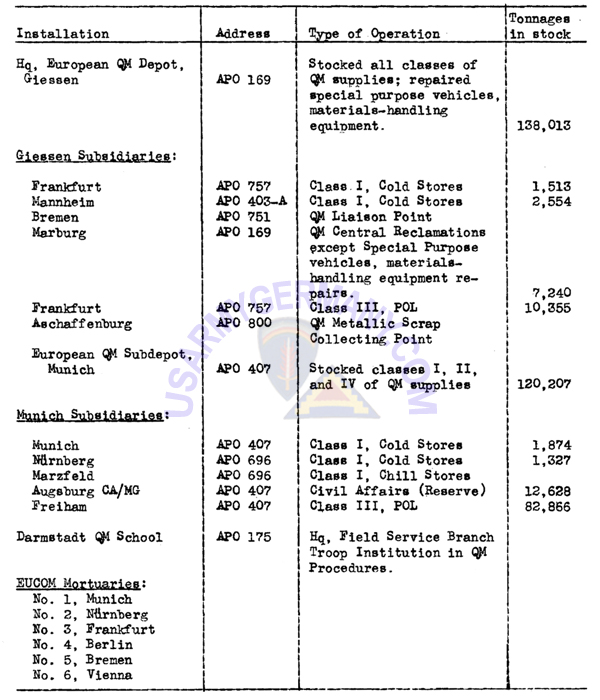
Table XIX: Quartermaster Installations |
| |
| 6. The European Quartermaster Depot.
 a. Staff and Organization. The European Quartermaster Depot at Giessen was the principal operational installation of the Quartermaster Division. Col. E. D. Ellis was commanding officer; Col. F. L. Thorpe, executive officer; Lt. Col. R. S. Miller, depot inspector; Maj. R. A. White, headquarters commandant; and Maj. David F. Tobin, adjutant. The Depot was authorized 220 American and Allied civilian employees. German workers were reduced from 10,600 to 9,400. The number of American, Allied, and German nationals assigned to the Giessen installation and its satellite depots on 30 June is shown in Table XX. Civilians working for the European Quartermaster Depot at the end of the quarter totaled 8,927. For the first time since activation all openings for German employees were filled. a. Staff and Organization. The European Quartermaster Depot at Giessen was the principal operational installation of the Quartermaster Division. Col. E. D. Ellis was commanding officer; Col. F. L. Thorpe, executive officer; Lt. Col. R. S. Miller, depot inspector; Maj. R. A. White, headquarters commandant; and Maj. David F. Tobin, adjutant. The Depot was authorized 220 American and Allied civilian employees. German workers were reduced from 10,600 to 9,400. The number of American, Allied, and German nationals assigned to the Giessen installation and its satellite depots on 30 June is shown in Table XX. Civilians working for the European Quartermaster Depot at the end of the quarter totaled 8,927. For the first time since activation all openings for German employees were filled.
|
| |
| Table XX: Workers in Giessen QM Installations, 30 June 1948 |
|
Location |
US Civilians |
|
Allied |
|
Local |
|
|
| |
|
|
|
|
|
|
|
|
| |
Giessen |
69 |
|
17 |
|
2,930 |
|
|
| |
Marburg |
6 |
|
0 |
|
817 |
|
|
| |
Frankfurt |
15 |
|
0 |
|
402 |
|
|
| |
Aschaffenburg |
0 |
|
0 |
|
31 |
|
|
| |
Mannheim |
21 |
|
3 |
|
1,227 |
|
|
| |
Bremen |
0 |
|
2 |
|
35 |
|
|
| |
Stuttgart |
1 |
|
0 |
|
9 |
|
|
| |
Munich |
51 |
|
5 |
|
2,348 |
|
|
| |
Freiham |
1 |
|
0 |
|
462 |
|
|
| |
Augsburg |
1 |
|
0 |
|
225 |
|
|
| |
Nürnberg |
0 |
|
0 |
|
249 |
|
|
| |
 Totals Totals |
165 |
|
27 |
|
8,735 |
|
|
|
| |
 b. Depot Operations. During the quarter the Procurement Division of the Giessen Depot prepared 221 contracts for Class I supplies obtained from European countries other than Germany. The value of these supplies was $9,927,189.56, Classes II and IV quartermaster supplies were procured through 21 contracts with European firms at a cost of $293,189.54. German sources provided 5,383.9 metric tons of wet and dry ice costing RM 100,589.39 for the cold store plants at Munich, Mannheim, Frankfurt, Bremen and Nürnberg. Manufacturers in Greater Hesse provided 1,876 pieces of furniture, while firms in the British Zone delivered 70 pieces. During the second quarter of 1948, 3,556 mattresses were renovated and work was started on the renovation of 100,000 pillows. Field inspectors from the depot made 455 visits to 50 factories and plants which were engaged in the production of quartermaster supplies. In an attempt to provide covered storage for all Class I supplies, 17,088 tons of such stocks was rewarehoused during the current quarter. Class I supplies received at the Giessen installation totaled 20,757 tons, while 35,673 tons were shipped from the Depot, The segregation of supplies of Classes II and IV and petroleum products was about 20 percent complete by the end of June. b. Depot Operations. During the quarter the Procurement Division of the Giessen Depot prepared 221 contracts for Class I supplies obtained from European countries other than Germany. The value of these supplies was $9,927,189.56, Classes II and IV quartermaster supplies were procured through 21 contracts with European firms at a cost of $293,189.54. German sources provided 5,383.9 metric tons of wet and dry ice costing RM 100,589.39 for the cold store plants at Munich, Mannheim, Frankfurt, Bremen and Nürnberg. Manufacturers in Greater Hesse provided 1,876 pieces of furniture, while firms in the British Zone delivered 70 pieces. During the second quarter of 1948, 3,556 mattresses were renovated and work was started on the renovation of 100,000 pillows. Field inspectors from the depot made 455 visits to 50 factories and plants which were engaged in the production of quartermaster supplies. In an attempt to provide covered storage for all Class I supplies, 17,088 tons of such stocks was rewarehoused during the current quarter. Class I supplies received at the Giessen installation totaled 20,757 tons, while 35,673 tons were shipped from the Depot, The segregation of supplies of Classes II and IV and petroleum products was about 20 percent complete by the end of June.
7. The European Quartermaster Sub-Depot.
Col. L. L. Skinner continued to command the Sub-Depot at Munich. This sub-depot received, stored, and issued quartermaster supplies to units in Austria and Bavaria, except the Aschaffenburg area. Its area included the military posts of Munich, Augsburg, Garmisch, Regensburg, and Nürnberg; the exempted air stations of Erding, Fürstenfeldbruck, Landsberg, Kaufbeuren, Neubiberg, and Oberpfaffenhofen; the 1st Division at Grafenwoehr; and the depot in Wels, Austria. It supplied 26 commissaries. On 1 June the Nürnberg Cold and Chill stores installations, formerly operated by the Giessen depot, were transferred to the Munich sub-depot, which also became responsible for supplying the Nürnberg post area. During the period under review, the sub-depot at Munich received 96,804 tons of supplies, shipped 112,322 tons, and rewarehoused 40,874 tons. To handle the supplies, 6,557 rail cars and 293 trucks were unloaded at the sub-depot, while 7,925 rail cars and 3,636 trucks were loaded.
8. The European Quartermaster School Center.
 a. Military Units. When maneuvers started at Grafenwoehr in April, Lt. Col. Charles H. Kirkland, former school commandant, took charge of the Constabulary QM Provisional Company, Infantry Division, and on 10 April Col. David H. Finley, former commanding officer of the Mannheim Depot, assumed command of the school center. At the end of June, military personnel assigned to the school formed one battalion, consisting of the Headquarters and Headquarters Company, 7717 EUCOM QMSC, the 512 QM Bakery Company, and Training Companies No. 1 and No. 2. The strength of the battalion on 30 June was 41 officers, 1 warrant officer, 299 enlisted men serving as cadre; and 341 students were in attendance at the school. Those figures included the 7 officers and 88 enlisted men who were placed on detached service to the Constabulary QM Company on 9 April for assignment to the Grafenwoehr Military Post. a. Military Units. When maneuvers started at Grafenwoehr in April, Lt. Col. Charles H. Kirkland, former school commandant, took charge of the Constabulary QM Provisional Company, Infantry Division, and on 10 April Col. David H. Finley, former commanding officer of the Mannheim Depot, assumed command of the school center. At the end of June, military personnel assigned to the school formed one battalion, consisting of the Headquarters and Headquarters Company, 7717 EUCOM QMSC, the 512 QM Bakery Company, and Training Companies No. 1 and No. 2. The strength of the battalion on 30 June was 41 officers, 1 warrant officer, 299 enlisted men serving as cadre; and 341 students were in attendance at the school. Those figures included the 7 officers and 88 enlisted men who were placed on detached service to the Constabulary QM Company on 9 April for assignment to the Grafenwoehr Military Post.
 b. Civilian Personnel. At the close of the quarter Germans employed for operational work numbered 111 compared to an authorization for 119, while 112 Germans were employed for service tasks, against an authorization for 115. Eight American civilians and one Allied civilian completed the staff of the school center. b. Civilian Personnel. At the close of the quarter Germans employed for operational work numbered 111 compared to an authorization for 119, while 112 Germans were employed for service tasks, against an authorization for 115. Eight American civilians and one Allied civilian completed the staff of the school center.
 c. Courses of Study. Lt. Col. James W. Nichols, assistant commandant, directed the courses offered by the Academic Division of the school in food service and technical training. When the Constabulary School was inactivated at Sonthofen, the supply course for noncommissioned officers was transferred to the European Quartermaster School Center. The following figures indicate the number of students graduated from courses given by the Technical Training Branch, as well as the number of students enrolled at the end of the quarter: c. Courses of Study. Lt. Col. James W. Nichols, assistant commandant, directed the courses offered by the Academic Division of the school in food service and technical training. When the Constabulary School was inactivated at Sonthofen, the supply course for noncommissioned officers was transferred to the European Quartermaster School Center. The following figures indicate the number of students graduated from courses given by the Technical Training Branch, as well as the number of students enrolled at the end of the quarter:
|
| |
|
Course |
Students
currently
enrolled
|
|
Graduated
during the
2nd quarter
|
|
Total students
graduated
to date
|
|
|
| |
|
|
|
|
|
|
|
|
| |
Administrative clerks (8 weeks) |
183 |
|
254 |
|
1,455 |
|
|
| |
NCO supply clerks (4 weeks) |
20 |
|
0 |
|
292 |
|
|
| |
Station and depot supply clerks (4 weeks) |
0 |
|
0 |
|
68 |
|
|
| |
Sentry dog training |
0 |
|
50 |
|
118 |
|
|
|
| |
The Food Service Training Branch offered six courses, and graduated 287 students during the quarter. On 30 June 111 students were enrolled in these classes. Instruction was provided for cooks, mess managers, bakers, stewards, and coffee roasters. The Coffee Roasting Shop provided weekly 2,100 pounds of roasted ground coffee, which was used at the school and the Rhine-Main Airport. Operated by students under supervision of the cadre, the Bakery furnished the two installations a weekly average of 14,656 pounds of bread.
 d. Field Service Branch Activities. The Food Service Supervisor, Lt. Col. Patrick H. Buckley, also continued to serve as the Chief of the Field Service Branch of the school center. Formerly known as the Field Service Division, this branch became part of the Administrative Service and Supply Division of the school on 20 June. Under the Field Service Branch were the Administration, Food Service, and Quartermaster Technical Inspector Sections. The Administration Section prepared information and reports for field use and for the Quartermaster Division, and coordinated activities of the food service teams. These teams advised mess personnel at installations on food preparation. During the quarter, 122 surveys were made by food service teams, bringing the number of such surveys to 1,133 since April 1947. Logistics Teams inspecting preventive maintenance of quartermaster organizational equipment made 34 surveys during the quarter, bringing the total number of surveys to 127 since April 1947. The Command and Unit Training Advisory Team, which usually inspected supply facilities, security and training measures, was on detached service at Grafenwoehr during the quarter under review. d. Field Service Branch Activities. The Food Service Supervisor, Lt. Col. Patrick H. Buckley, also continued to serve as the Chief of the Field Service Branch of the school center. Formerly known as the Field Service Division, this branch became part of the Administrative Service and Supply Division of the school on 20 June. Under the Field Service Branch were the Administration, Food Service, and Quartermaster Technical Inspector Sections. The Administration Section prepared information and reports for field use and for the Quartermaster Division, and coordinated activities of the food service teams. These teams advised mess personnel at installations on food preparation. During the quarter, 122 surveys were made by food service teams, bringing the number of such surveys to 1,133 since April 1947. Logistics Teams inspecting preventive maintenance of quartermaster organizational equipment made 34 surveys during the quarter, bringing the total number of surveys to 127 since April 1947. The Command and Unit Training Advisory Team, which usually inspected supply facilities, security and training measures, was on detached service at Grafenwoehr during the quarter under review.
9. Food Problems.
 a. Results of Survey of Unit Mess Halls. In a survey made by the Deputy Inspector General during the first quarter of 1948, which covered 70 unit mess halls, at least 25 percent of the men in 47 units had stated that they did not receive enough food. The Deputy Inspector General attributed this dissatisfaction to four factors: (1) reduced allowances of certain food items, especially bread, as a result of the food Conservation Program inaugurated by the Department of the Army in October 1947; (2) illicit removal of troop rations by German workers in the mess; (3) the lack of second servings; and (4) the failure of company grade officers and their immediate superiors to provide adequate command supervision of their messes. A resurvey of 12 messes which had received the lowest ratings substantiated the conclusions reached by the Deputy Inspector General. a. Results of Survey of Unit Mess Halls. In a survey made by the Deputy Inspector General during the first quarter of 1948, which covered 70 unit mess halls, at least 25 percent of the men in 47 units had stated that they did not receive enough food. The Deputy Inspector General attributed this dissatisfaction to four factors: (1) reduced allowances of certain food items, especially bread, as a result of the food Conservation Program inaugurated by the Department of the Army in October 1947; (2) illicit removal of troop rations by German workers in the mess; (3) the lack of second servings; and (4) the failure of company grade officers and their immediate superiors to provide adequate command supervision of their messes. A resurvey of 12 messes which had received the lowest ratings substantiated the conclusions reached by the Deputy Inspector General.
 b. Corrective Measures. To correct the situation, Headquarters, EUCOM obtained permission from the Department of the Army to restore the ration to the level authorized before October 1947, when the conservation program was begun. EUCOM food service advisory teams and food service supervisors of major commands emphasized the importance of eliminating unauthorized meals for German mess workers. Principal complaints came from consolidated messes, so the advisory teams recommended organizational mess halls to replace the larger messes. They also urged additional helpings when requested, that management be improved, and that serving lines move faster. Troop commanders were reminded they were personally responsible for any negligence in messes under their ,jurisdiction, The EUCOM Menu Planning Board established in March, was reorganized with more enlisted men as members, and they were encouraged to express their opinions. The Ghief, Quartermaster Division, recommended that German mess attendants should not exceed 10 percent of the members of a mess, that they should serve only as kitchen police, waiters, or dishwashers, and that only military personnel be food technicians. b. Corrective Measures. To correct the situation, Headquarters, EUCOM obtained permission from the Department of the Army to restore the ration to the level authorized before October 1947, when the conservation program was begun. EUCOM food service advisory teams and food service supervisors of major commands emphasized the importance of eliminating unauthorized meals for German mess workers. Principal complaints came from consolidated messes, so the advisory teams recommended organizational mess halls to replace the larger messes. They also urged additional helpings when requested, that management be improved, and that serving lines move faster. Troop commanders were reminded they were personally responsible for any negligence in messes under their ,jurisdiction, The EUCOM Menu Planning Board established in March, was reorganized with more enlisted men as members, and they were encouraged to express their opinions. The Ghief, Quartermaster Division, recommended that German mess attendants should not exceed 10 percent of the members of a mess, that they should serve only as kitchen police, waiters, or dishwashers, and that only military personnel be food technicians.
10. Materials Handling Equipment.
Improvement was noted in the maintenance of materials-handling equipment an the result of the training given to operators and maintenance workers. The Quartermaster Division issued monthly memoranda on the use and maintenance of various items of equipment. At the end of June, 965 standard types of materials-handling equipment were in use, with 99 nonstandard items still awaiting replacement. Of approximately 70 organizations, 33 had only authorized models by the end of June. Base maintenance facilities were provided by the European Quartermaster Depot at Giessen, which rebuilt assemblies, and by German firms, which rebuilt fork lift truck engines on contracts. Rebuilding of materials-handling equipment for the first six months of 1948 was: |
| |
|
|
JAN |
FEB |
MAR |
APR |
MAY |
JUN |
|
|
| |
|
|
|
|
|
|
|
|
|
| |
Received for rebuild |
8 |
0 |
0 |
0 |
0 |
2 |
|
|
| |
Rebuilt |
22 |
18 |
28 |
30 |
24 |
22 |
|
|
| |
Issued |
5 |
8 |
12 |
37 |
31 |
33 |
|
|
|
| |
| By 30 June the Quartermaster Division had recovered 204 pieces of excess and unauthorized types of equipment. The lack of parts ordered from the United States retarded rebuilding assemblies at shops at Berlin, Bremerhaven, Erding, Fontainebleau, Giessen, and Munich. About 12 tons of rebuild parts were expected from the United States by 1 August. In addition to the six field maintenance shops, the following using agencies repaired materials-handling equipment: the Hanau Engineer Depot, the Hanau Signal Depot, the Ordnance Base Maintenance Center, the Butzbach Ordnance Shop, and the Ordnance depots at Griesheim, Karlsfeld, Kassel, Mannheim, and Nordenham.
11. Surplus Property Disposal.
Of a total of 87,660 long tons of surplus quartermaster stocks destined for the Germans, 11,257 long tons, having a dollar value of $3,778,700, had been transferred by the end of June. About 22,380 long tons of the total amount had been declared to the Office of the Foreign Liquidation Commissioner but remained unsold as of 25 April. These supplies therefore were to be transferred to STEG, the German receiving agency. In May the Quartermaster Division requested depot commanders to supplant the daily reports of surplus property shipments with reports submitted on the 15th and 30th of each month. Following the removal of all supplies required by the Army, the Quartermaster Disposal Center Designates at Bamberg and Lemwerder were released on 30 April to STEG. On 17 May STEG took possession of the Quartermaster Salvage Installation and Civil Affairs Depot at Friedrichsfeld. 12. Procurement.
 a. Problems Encountered. During the period under review an estimated 60 percent of subsistence contracts were fulfilled. Headquarters, EUCOM, did not authorize contracts containing liquidated damage clauses or requiring performance bonds and purchase against the contractor. Hence firms filled their contracts only when they considered it profitable. The Quartermaster Division requested the Logistics Division to authorize the use of enforceable contracts, but no action was taken during this period. Other difficulties encountered by the Procurement Section were the lack of qualified procurement personnel, the shortage of transportation, and the many requests for special procurement originating from persons with VIP standing. a. Problems Encountered. During the period under review an estimated 60 percent of subsistence contracts were fulfilled. Headquarters, EUCOM, did not authorize contracts containing liquidated damage clauses or requiring performance bonds and purchase against the contractor. Hence firms filled their contracts only when they considered it profitable. The Quartermaster Division requested the Logistics Division to authorize the use of enforceable contracts, but no action was taken during this period. Other difficulties encountered by the Procurement Section were the lack of qualified procurement personnel, the shortage of transportation, and the many requests for special procurement originating from persons with VIP standing.
 b. Subsistence Obtained During Quarter. The amount of subsistence obtained during the quarter under review and the countries from which the various items were obtained are shown in Table XXI. b. Subsistence Obtained During Quarter. The amount of subsistence obtained during the quarter under review and the countries from which the various items were obtained are shown in Table XXI.
|
| |
| Table XXI: Subsistence Purchases |
|
Item |
Country |
Quantity
contracted
|
Value |
|
|
| |
|
|
|
|
|
|
| |
Eggs |
Denmark |
480,000 dozen |
$297,600.00 |
|
|
| |
Eggs |
Switzerland |
729,000 dozen |
$441,189.60 |
|
|
| |
Eggs |
Holland |
1,750,020 dozen |
$1,085,012.40 |
|
|
| |
Milk |
Denmark |
4,290,000 liters |
$759,330.00 |
|
|
| |
Butter, bulk |
Denmark |
158,730 pounds |
$106,349.10 |
|
|
| |
Butter, print |
Denmark |
238,095 pounds |
$164,285.55 |
|
|
| |
Vegetables |
Belgium, Denmark |
1,777,855 kilos |
$291,165.67 |
|
|
| |
Vegetables |
France, Holland |
1,398,713 kilos |
$327,514.43 |
|
|
| |
Vegetables |
Italy, Switzerland |
3,898,093 kilos |
$457,837.17 |
|
|
| |
Fresh fruits |
Belgium, France |
30,112 kilos |
$2,077.73 |
|
|
| |
Fresh fruits |
Italy, Switzerland |
331,134 kilos |
$76,191.94 |
|
|
|
|
| |
| (Source: Vol. IV, 3rd Quarter, The Third Year of Occupation, OCCUPATION FORCES SERIES, Hq EUCOM, 1948) |
| Table IV: Quartermaster Station List (on 25 March 1948) |
| |
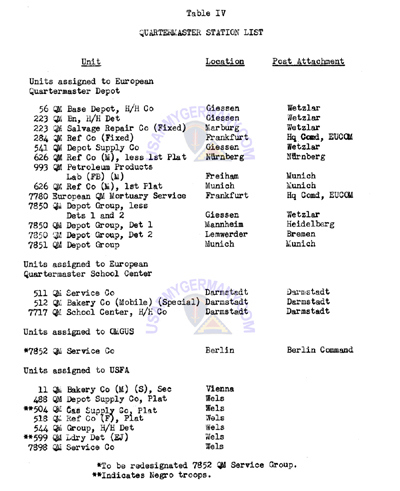
Click on image to enlarge
|
 |
|
| |
| QM Units & Activities in the 1940s |
| |
| Mannheim Quartermaster Base Depot |
| |
| |
| |
| |
|
|
| 4359th QM Bakery Company (Mobile) (Special) |
| |
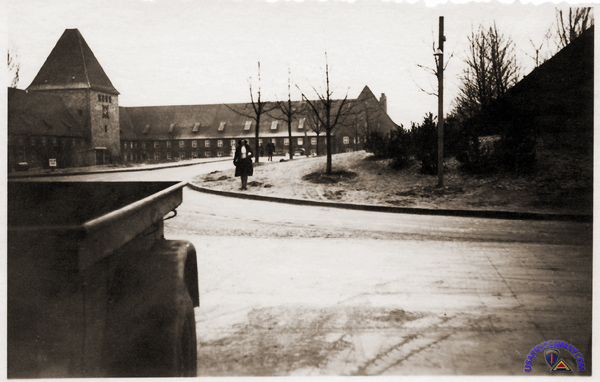
Flak Kaserne, Zirndorf, late 1945 - home of the 4359th QM Bkry Co (Mbl)(Sp) |
| |
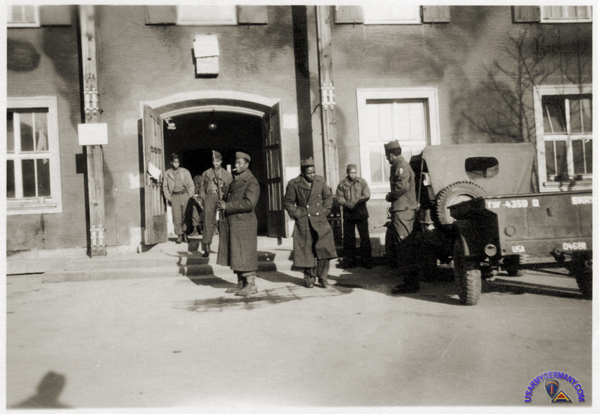
Members of the 4359th QM have some fun in front of their barracks, late 1945 |
| |
| (Information on Bakery companies during WWII - 3032nd Bakery Company in Toul, France) |
The table of organization and equipment for the mobile bakery company (during WWII and in the immediate post-war period) called for three major pieces of equipment:
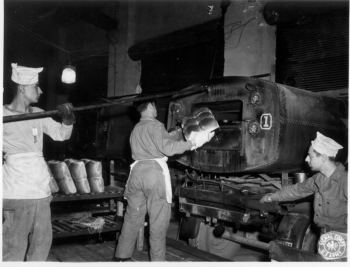
The oven trailers consisted each of a two-chambered oven mounted on a trailer (US Army photo, WWII).
Webmaster note: based on a review of the December 1945 Telephone Directory for Nürnberg (military), I believe that primarily TSFET units were stationed at Flak Kaserne in those early days after VE-Day after it had served as a Third Army QM sub-depot. (More on that when I collect more details.) |
4359th QM Bkry Co
Zirndorf |
|
|
|
|
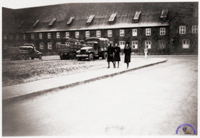 1. Flak Kaserne, 1945 1. Flak Kaserne, 1945 |
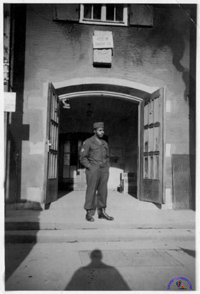 2. Entrance to 4359th barracks 2. Entrance to 4359th barracks |
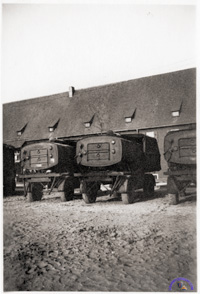 3. Oven trailers 3. Oven trailers |
|
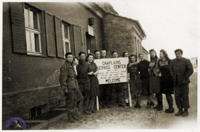 4. Chaplains service center 4. Chaplains service center |
|
|
|
|
 |
|
| |
Related Links:
|
| |
| |
|












